In another time and another place this was a game between FA Cup Winners and League Cup Winners, a fixture played between two teams from the top division of the professional game in England. Last season it was a match that marked their respective debuts in the Blue Square Conference Premier Division and on Saturday 21 May 2011 they faced each other in the biggest game in Non-League football – the Blue Square Bet Premier Promotion Final. The winners securing the prize of promotion to the npower League Two and back into the fold of the English games top 92 clubs. If you haven’t guessed by now, the teams in question are AFC Wimbledon and Luton Town.
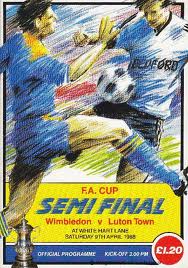 In 1988, the month of April was an interesting time for Wimbledon FC and Luton Town. The teams met in the FA Cup Semi-Final at White Hart Lane on the 9th of that month. Wimbledon emerged victors that day with a 2-1 win on their way to a completely unexpected FA Cup Final victory over Liverpool. Luton though bounced back and just 15 days later carried out their own Cup shock by stunning Arsenal 3-2 at Wembley with two goals in the last eight minutes to take the League Cup. The 23 years since these sides won major domestic honours have seen countless twists and turns, many of which have been cruel, whilst others have been inspirational.
In 1988, the month of April was an interesting time for Wimbledon FC and Luton Town. The teams met in the FA Cup Semi-Final at White Hart Lane on the 9th of that month. Wimbledon emerged victors that day with a 2-1 win on their way to a completely unexpected FA Cup Final victory over Liverpool. Luton though bounced back and just 15 days later carried out their own Cup shock by stunning Arsenal 3-2 at Wembley with two goals in the last eight minutes to take the League Cup. The 23 years since these sides won major domestic honours have seen countless twists and turns, many of which have been cruel, whilst others have been inspirational.
For Wimbledon, the FA Cup win was the pinnacle of an incredible journey that only saw them come into the Football League in the 1977/78 season. Following the Cup win, the Dons finished in 12th position in 1988/89 in the First Division, and had very respectable finishes in 1989/90 and 1990/91 of 8th and 7th respectively. However, storm clouds were gathering behind the scenes with regard to their Plough Lane ground and in order to meet the requirements relating to all seater stadia moved to Selhurst Park to ground share with Crystal Palace from the 1991/92 season. This proved to be an unsettling period for the Dons with three managers (Ray Harford, Peter Withe and Joe Kinnear) seeing out that last First Division season prior to the formation of the FA Premier League. Wimbledon continued to defy their critics with year on year respectable League finishes and in 1996/97, the Dons reached both the FA and League Cup Semi-Finals as well as finishing 8th. Joe Kinnear was an inspirational manager during his period as manager in the nineties and when he stepped down due to ill health prior to the 1999/2000 season, the consequences for the club were to prove terminal. Controversial Norwegian coaching guru Egil Olsen was appointed, but his tenure didn’t last the season and it was left to Terry Burton to oversee an unfortunate last day relegation from the Premier League.
This relegation was part of the beginning of one of the most distasteful acts that has taken place in English football. With the Dons unable to regain their Premier League status at the start of the new millennium, the club decided in August 2001 that it was to move to Milton Keynes. There was outrage amongst fans but it was to no avail and the relocation was sanctioned in May 2002. Thankfully the Dons faithful rallied and AFC Wimbledon were founded and the club today as it was then, are wholly owned by the supporters via the one-fan, one vote Dons Trust. The 2002/03 season saw AFC Wimbledon ground share with Kingstonian FC under the leadership of ex-Dons player Terry Eames and participated in the Combined Counties League. Prior to 2003/04 the Dons bought the ground and went onto secure promotion to the Isthmian League Divison One under caretaker manager Nicky English after Eames was sacked in February 2004 on disciplinary grounds. A second straight promotion followed in 2004/05 under new manager Dave Anderson and AFC Wimbledon found themselves on the up once more and in the Isthmian Premier. However, Anderson couldn’t make the next breakthrough and current boss Terry Brown came to the club for the 2007/08 season and immediately led the Dons into the Conference South. Brown then managed another promotion into the Conference Premier after securing the title in 2008/09 for the Dons. And so after one season acclimatising to life in the top flight of Non-League football, the Dons have battled their way to the Play-Off Final after a convincing 8-1 aggregate win over Fleetwood Town.
So from that heady day in April 1988 when Steve Foster held aloft the League Cup at Wembley, how have the Hatters found themselves at the City of Manchester Stadium battling to regain their League status? A year after the 1988 triumph Luton were back at Wembley to defend the League Cup only to lose 3-1 to Nottingham Forest. Sadly their League form was in decline and in the following seasons they only just clung onto their First Division status, finishing 16th (1988/89), 17th (1989/90) and 18th (1990/91). Finally in 1991/92 their luck ran out and Luton along with Notts County and West Ham were relegated, so missing out on the inaugural Premier League season. Things didn’t fare any better in 1992/93 and 1993/94 as the Hatters only avoided relegation in both seasons by two points. Whilst in 1994/95 the Hatters finished a comparatively comfortable 16th place, David Pleat left the club after his second stint as manager ended with Lennie Lawrence taking over. However, a change of leadership didn’t help the Hatters as they were relegated to the third tier of English football. In 1996-97 Luton did manage to finish third to make the Play-offs, but lost to Crewe in the Semi-Final games 4-3 on aggregate. There followed three seasons of mid to lower league finishes, before relegation to the bottom tier of the professional game in 2000/01. Joe Kinnear came to the club and achieved promotion as runners-up with the club the following season. There looked to be stability about the team when in 2002/03 Kinnear took the Hatters to a competitive 9th place finish. However, in May 2003 John Gurney sacked Kinnear and in came Mike Newell. With a summer of confusion and the club in administration, Newell’s first season saw a 10th place finish and then lead the Hatters to an impressive title winning season in 2004/05. 2005/06 saw a respectable if unspectacular 10th finish in the Championship under Mike Newell and did nothing to hint at what would happen to the Bedfordshire club in the next 6 years.
Against a backdrop of more financial uncertainty, the 2006/07 season in the Championship was not a memorable one for the team from Kenilworth Road, with the club being relegated with 40 points. Worse was to follow in 2007/08 as the season saw the club in administration and with a 10 point deduction, drop further down the League ladder, as they finished bottom of League One. Luton fans must have wondered if things could get any worse, but they did as the club started the 2008/09 in League Two with a devastating deduction of 30 points. Mick Harford bravely saw his team accumulate 56 points, enough to have seen the Hatters finish in 15th position, but for the deduction. With 26 points Luton were placed bottom. Despite their inevitable relegation, Luton picked up the Football League Trophy in front of over 55,000 fans at Wembley, overcoming Scunthorpe United 3-2. However, this couldn’t take the edge off the club having to drop out of the Football League. Under Richard Money, 2009/10 saw Luton finish second in their first season in the Conference Premier, but didn’t make it to the Play-off Final after losing both legs of the Semi-Final Play-offs 1-0 to York City. Money looked set to take Luton into the Play-offs once more this season, but left the club in March being replaced by Gary Brabin. Brabin steered the Hatters to finishing third in the Conference Premier table, 6 points behind the Dons, and through 5-1 on aggregate against Wrexham in the Semi-Final Play-offs.
For my part, my journey to this game goes back to 1976 when as a Fulham fan, I was taken to Plough Lane to see Wimbledon beat Sutton United 3-1 a FA Trophy First Round replay. Whilst I remained loyal to the Whites from Craven Cottage, I’ve always had a soft spot for the Dons and that game sparked my love of Non-League football. If Fulham were away, I would head for Wimbledon and was there the day they played Halifax Town in their first game in Division Four in August 1977. I’ll lay my cards on the table and say without hesitation that AFC Wimbledon are the continuation of the original club. MK Dons should never have been sanctioned and my wish is to see them out of the League structure – they have no place in the Football League.
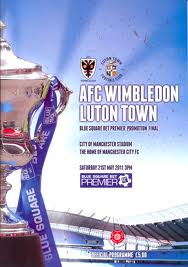 Therefore I travel to this game as nervous as any fan. As I set off for the match from Leeds station I spot a Luton Town shirt and think, is that an omen? Are Luton going to win 1-0? Quickly I see an AFC Wimbledon shirt which makes it 1-1. In search of a winner, I search the platforms but don’t see any further shirts as I board the train. The journey is spent looking out the window, checking the time and suddenly we are stopping at Huddersfield. Surely that’s a good omen for the Dons, as that is where Wimbledon got promoted to the First Division after a 1-0 win at the old Leeds Road ground back in May 1986. Onwards we go again and without realising it I can see the City of Manchester Stadium coming into view. For Luton fans, if they think of Manchester and particularly the blue half, they must think of the relegation game on the last day of the 1982/83 season. I can remember watching it on Match of the Day and David Pleat’s hop, skip and a jump as a last gasp Raddy Antic goal saved the Hatters and relegated City.
Therefore I travel to this game as nervous as any fan. As I set off for the match from Leeds station I spot a Luton Town shirt and think, is that an omen? Are Luton going to win 1-0? Quickly I see an AFC Wimbledon shirt which makes it 1-1. In search of a winner, I search the platforms but don’t see any further shirts as I board the train. The journey is spent looking out the window, checking the time and suddenly we are stopping at Huddersfield. Surely that’s a good omen for the Dons, as that is where Wimbledon got promoted to the First Division after a 1-0 win at the old Leeds Road ground back in May 1986. Onwards we go again and without realising it I can see the City of Manchester Stadium coming into view. For Luton fans, if they think of Manchester and particularly the blue half, they must think of the relegation game on the last day of the 1982/83 season. I can remember watching it on Match of the Day and David Pleat’s hop, skip and a jump as a last gasp Raddy Antic goal saved the Hatters and relegated City.
I change trains at Manchester Piccadilly and take a local service to Ashburys. A short walk and I’m at the stadium. So far all I’ve seen are Hatters fans, but then realise that this area is designated for the Orange Army. Much has been made pre-match about he ticket prices and I’m sure the attendance will be affected by the sky-high prices and associated admin and booking fees.
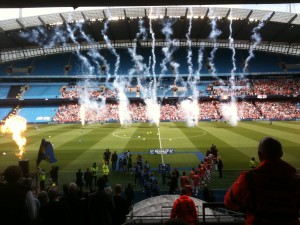 About 2.30 I make my way to my seat and I’m struck by how well the pitch looks. With mid-May sun lighting up the pitch and stadium it could be the opening day of the season in August. The teams go through their pre-match drills and as the respective sets of supporters drift in the volume and sense of anticipation increases. To my right and ahead of me there is a sea of orange and in the area I’m sat and to my left, the blue and yellow of the Dons fans is evident. The players go off to applause, knowing the next time that emerge onto the pitch the real action will begin. There is a brief lull. All around me there is expectation and this is reflected in faces that are anxious and faces that are just enjoying the moment. Sunshine greets the players as they enter the arena passing the Play-off Trophy and the volume reaches a new high for the day. Fireworks burst into life and jets of flames add to an already hot atmosphere. The team’s line-up, but quickly officials are ushering them into a different position as they await the presentation of match guests. As they do so, players nervously wave to loved ones in the crowd. All those around me agree that the game is too close to call and that one goal will win it.
About 2.30 I make my way to my seat and I’m struck by how well the pitch looks. With mid-May sun lighting up the pitch and stadium it could be the opening day of the season in August. The teams go through their pre-match drills and as the respective sets of supporters drift in the volume and sense of anticipation increases. To my right and ahead of me there is a sea of orange and in the area I’m sat and to my left, the blue and yellow of the Dons fans is evident. The players go off to applause, knowing the next time that emerge onto the pitch the real action will begin. There is a brief lull. All around me there is expectation and this is reflected in faces that are anxious and faces that are just enjoying the moment. Sunshine greets the players as they enter the arena passing the Play-off Trophy and the volume reaches a new high for the day. Fireworks burst into life and jets of flames add to an already hot atmosphere. The team’s line-up, but quickly officials are ushering them into a different position as they await the presentation of match guests. As they do so, players nervously wave to loved ones in the crowd. All those around me agree that the game is too close to call and that one goal will win it.
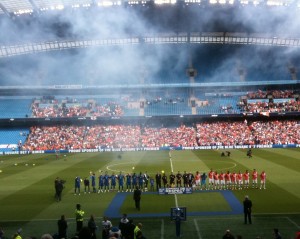 Wimbledon kick-off, but immediately give it away and concede a free-kick. The game is held up further as players stamp on blue and yellow balloons that drift across the playing surface. Play resumes and within the opening first five minutes Luton and AFC Wimbledon both win corners, which neither defence defends comfortably. Gary Brabin the Luton manager, arms folded prowls around his Technical area. His opposite number Terry Brown remains seated during the opening exchanges. The defences look nervous and Seb Brown in goal for the Dons doesn’t come for a through ball. Suddenly the ball switches into the Luton half, seven minutes gone, Kaid Mohamed shoots, Hatters keeper Tyler saves and Kedwell crashes home the rebound. The Dons players, fans and management explode with joy, but it is short-lived, the linesman flag indicates off-side, Hatters fans taunt their rivals. Luton respond well and have a couple of shots off target. Terry Brown the Dons manager is now out in his Technical Area as the first third of the first half elapses. There is a great deal of tension in the play and possession is too easily given away and corners and free-kicks are wasted by both sides, the prize so much of a burden at this stage. Twenty minutes gone and Luton start to build some pressure, as they win another corner. A fine save by Brown from Claude Gnakpa, as the Frenchman gets into the game. Still the mistakes continue as a Luton player throws the ball straight out of play, both managers exchange a smile to relieve their tension briefly. Thirty minutes gone and Luton are enjoying a good spell, Dons skipper Kedwell knows this and his sense of frustration is evident. Gnakpa threatens the Dons defence once more, but is fouled by Brett Johnson and the first booking of the day is made. With five minutes before half time, AFC Wimbledon have a decent spell and their supporters are lifted. Good runs are made down the wings, but lack of numbers or poor delivery means the chances are lost. The official holds up the board to indicate 2 minutes of time added on and with it a booking for Luton’s Keith Keane. Half-time. Those around discuss a first half of wasted possession and an AFC Wimbledon team that currently has a midfield that appears to be playing too deep. Others around me continue with the mantra that one goal will be enough to win it.
Wimbledon kick-off, but immediately give it away and concede a free-kick. The game is held up further as players stamp on blue and yellow balloons that drift across the playing surface. Play resumes and within the opening first five minutes Luton and AFC Wimbledon both win corners, which neither defence defends comfortably. Gary Brabin the Luton manager, arms folded prowls around his Technical area. His opposite number Terry Brown remains seated during the opening exchanges. The defences look nervous and Seb Brown in goal for the Dons doesn’t come for a through ball. Suddenly the ball switches into the Luton half, seven minutes gone, Kaid Mohamed shoots, Hatters keeper Tyler saves and Kedwell crashes home the rebound. The Dons players, fans and management explode with joy, but it is short-lived, the linesman flag indicates off-side, Hatters fans taunt their rivals. Luton respond well and have a couple of shots off target. Terry Brown the Dons manager is now out in his Technical Area as the first third of the first half elapses. There is a great deal of tension in the play and possession is too easily given away and corners and free-kicks are wasted by both sides, the prize so much of a burden at this stage. Twenty minutes gone and Luton start to build some pressure, as they win another corner. A fine save by Brown from Claude Gnakpa, as the Frenchman gets into the game. Still the mistakes continue as a Luton player throws the ball straight out of play, both managers exchange a smile to relieve their tension briefly. Thirty minutes gone and Luton are enjoying a good spell, Dons skipper Kedwell knows this and his sense of frustration is evident. Gnakpa threatens the Dons defence once more, but is fouled by Brett Johnson and the first booking of the day is made. With five minutes before half time, AFC Wimbledon have a decent spell and their supporters are lifted. Good runs are made down the wings, but lack of numbers or poor delivery means the chances are lost. The official holds up the board to indicate 2 minutes of time added on and with it a booking for Luton’s Keith Keane. Half-time. Those around discuss a first half of wasted possession and an AFC Wimbledon team that currently has a midfield that appears to be playing too deep. Others around me continue with the mantra that one goal will be enough to win it.
The first half sun has given way to grey skies as Luton kick-off the second half. The Dons continue as they finished the first half and look more threatening in the first ten minutes of the second period. Luton’s turn to be frustrated and Lawless, rather suitably names, goes into the book. Wimbledon continue to press as the hour mark approaches. The announcer gives the crowd at 18,195 – I look round, and consider that the Dons fans are outnumbered 2 to 1. Surely the Conference can’t be happy with the attendance and must look at how this years arrangements were made. As the game enters the last 30 minutes, both sides made changes, Matthew Barnes-Homer replaces Robbie Willmott for the Hatters and Ismail Yakubu is brought on as a substitute for Gareth Gwillim. The changes cause a bit of a lull in the game and the crowd is quietened briefly. Luton bring the match back to life as first Kroca, then Asafu-Adjave have shots off target for the Hatters. The Dons manager brings off Wellard and on comes Mulley. The impact is immediate as the latest Dons substitute curls in a shot which Tyler pushes away for a corner. As the game hits 70 minutes, Yakubu has work to do at both ends. First he fires off target for the Dons, but then is called into defensive duty on two occasions to null the Hatters threat. Gnakpa continues to be lively for Luton, but with just ten minutes to go, Extra-Time is looking inevitable. Luke Moore gets a yellow card as certain players look to be feeling the strain of the game both emotionally and physically. Bradin the Luton manager disputes a decision and the referee has to come over to defuse the situation. With five minutes remaining the Dons look more likely to score and a succession of half-chances come and go. Then in the space of two minutes Luton are denied first by heroic blocking from the Dons defence and then what looks like a goal bound header from Walker comes back off the post. The official signals four minutes of added time, but everyone is resigned to another 30 minutes.
The first period of Extra-Time seems to flash past. Few genuine chances are created as weary bodies and minds try to keep going. The dangerous Gnakpa departs for Luton as Newton comes on, whilst for the Dons, Minshull replaces Steven Gregory. Before we know it the final 15 minutes is underway and Wimbledon suddenly appear stronger, Minshull gets himself booked, but chances are created by the Dons. And with the last attack of the game Yakubu misses with a header with his skipper behind him perhaps better placed. That’s it – the lottery of penalties is the fate for these two teams.
The five players with the dubious pleasure of taking the pressure kicks line-up on the half-way line, separated from the rest of their team-mates who link arms on the sidelines. The respective keepers share a joke and make their way to the end where the Blue and Yellow ranks of the AFC Wimbledon fans are seated. Luton take the first spot-kick and England C International Brown saves from Alex Lawless. The Dons fans erupt and then calms as Sam Hatton steps up. He confidently put away the kick and his team are ahead 1-0. Pilkington, Moore and Newton all score their penalties making it 2-2 with Mohamed getting the chance to restore the Dons lead. The hat-trick hero of the Semi-Finals steps up and his kick is saved and the advantage is gone. Two penalties left for both sides. If Walker scores, Luton are ahead for the first time in the penalties and the pressure would be on the Dons. However, Brown is the hero again; his up-stretched and bear-like hand claws the ball away. Substitute Yakubu steps up and coolly puts ball away, sending the Blue and Yellow fans into raptures. Luton must score to keep their dream alive. Jake Howells is equal to the pressure and brings the scores level at 3 all. However, he and his team-mates know that if AFC Wimbledon skipper Kedwell scores, the Hatters are destined for another season in the Conference. Up steps the skipper and blasts the ball home. This cruellest of ends to any game sparks utter euphoria to my left and utter despair to my right.
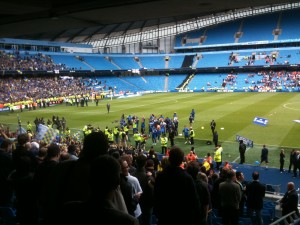 The Orange Army no longer glimmers in the late May sunshine. They stay and applaud their team as the players collect their loser’s medals. I turn to watch the scenes of joy at the Dons end of the stadium as they leap and hug each other and as players bring their children onto the pitch. Amidst it all the managers congratulate/commiserate with each other. As the Dons climb the stairs to collect their prize, I glance to look where the Luton massed ranks were – there now is only empty light blue seats. With Danny Kedwell raising the Trophy, the fans erupt into cheers once more. Now as the players make their way to the pitch podium for more pictures a new chorus emerges from the travelling Dons fans, “…9 years, it only took 9 years, it only took 9 years…” Yes, just a nine year journey from the Combined Counties League to the Football League. Another remarkable story in the history of a remarkable club.
The Orange Army no longer glimmers in the late May sunshine. They stay and applaud their team as the players collect their loser’s medals. I turn to watch the scenes of joy at the Dons end of the stadium as they leap and hug each other and as players bring their children onto the pitch. Amidst it all the managers congratulate/commiserate with each other. As the Dons climb the stairs to collect their prize, I glance to look where the Luton massed ranks were – there now is only empty light blue seats. With Danny Kedwell raising the Trophy, the fans erupt into cheers once more. Now as the players make their way to the pitch podium for more pictures a new chorus emerges from the travelling Dons fans, “…9 years, it only took 9 years, it only took 9 years…” Yes, just a nine year journey from the Combined Counties League to the Football League. Another remarkable story in the history of a remarkable club.
MK beware– the real Dons are back!
Paul Hatt – Editor
 Don Howe is one of English football’s great coaches, with an unrivalled record at international and club level.
Don Howe is one of English football’s great coaches, with an unrivalled record at international and club level.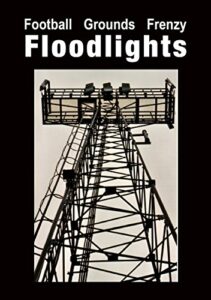 As a kid travelling to away games, spotting the floodlights was part of the excitement of the day. And if I’m honest, even all these years later, there is still a thrill from spotting the pylons whether in the car or on a train. However, as old grounds have slowly disappeared and technology has advanced in the field of lighting, those distinctive pylons of my youth, are a very rare sight these days.
As a kid travelling to away games, spotting the floodlights was part of the excitement of the day. And if I’m honest, even all these years later, there is still a thrill from spotting the pylons whether in the car or on a train. However, as old grounds have slowly disappeared and technology has advanced in the field of lighting, those distinctive pylons of my youth, are a very rare sight these days. In 1988, the month of April was an interesting time for Wimbledon FC and Luton Town. The teams met in the FA Cup Semi-Final at White Hart Lane on the 9th of that month. Wimbledon emerged victors that day with a 2-1 win on their way to a completely unexpected FA Cup Final victory over Liverpool. Luton though bounced back and just 15 days later carried out their own Cup shock by stunning Arsenal 3-2 at Wembley with two goals in the last eight minutes to take the League Cup. The 23 years since these sides won major domestic honours have seen countless twists and turns, many of which have been cruel, whilst others have been inspirational.
In 1988, the month of April was an interesting time for Wimbledon FC and Luton Town. The teams met in the FA Cup Semi-Final at White Hart Lane on the 9th of that month. Wimbledon emerged victors that day with a 2-1 win on their way to a completely unexpected FA Cup Final victory over Liverpool. Luton though bounced back and just 15 days later carried out their own Cup shock by stunning Arsenal 3-2 at Wembley with two goals in the last eight minutes to take the League Cup. The 23 years since these sides won major domestic honours have seen countless twists and turns, many of which have been cruel, whilst others have been inspirational. Therefore I travel to this game as nervous as any fan. As I set off for the match from Leeds station I spot a Luton Town shirt and think, is that an omen? Are Luton going to win 1-0? Quickly I see an AFC Wimbledon shirt which makes it 1-1. In search of a winner, I search the platforms but don’t see any further shirts as I board the train. The journey is spent looking out the window, checking the time and suddenly we are stopping at Huddersfield. Surely that’s a good omen for the Dons, as that is where Wimbledon got promoted to the First Division after a 1-0 win at the old Leeds Road ground back in May 1986. Onwards we go again and without realising it I can see the City of Manchester Stadium coming into view. For Luton fans, if they think of Manchester and particularly the blue half, they must think of the relegation game on the last day of the 1982/83 season. I can remember watching it on Match of the Day and David Pleat’s hop, skip and a jump as a last gasp Raddy Antic goal saved the Hatters and relegated City.
Therefore I travel to this game as nervous as any fan. As I set off for the match from Leeds station I spot a Luton Town shirt and think, is that an omen? Are Luton going to win 1-0? Quickly I see an AFC Wimbledon shirt which makes it 1-1. In search of a winner, I search the platforms but don’t see any further shirts as I board the train. The journey is spent looking out the window, checking the time and suddenly we are stopping at Huddersfield. Surely that’s a good omen for the Dons, as that is where Wimbledon got promoted to the First Division after a 1-0 win at the old Leeds Road ground back in May 1986. Onwards we go again and without realising it I can see the City of Manchester Stadium coming into view. For Luton fans, if they think of Manchester and particularly the blue half, they must think of the relegation game on the last day of the 1982/83 season. I can remember watching it on Match of the Day and David Pleat’s hop, skip and a jump as a last gasp Raddy Antic goal saved the Hatters and relegated City. About 2.30 I make my way to my seat and I’m struck by how well the pitch looks. With mid-May sun lighting up the pitch and stadium it could be the opening day of the season in August. The teams go through their pre-match drills and as the respective sets of supporters drift in the volume and sense of anticipation increases. To my right and ahead of me there is a sea of orange and in the area I’m sat and to my left, the blue and yellow of the Dons fans is evident. The players go off to applause, knowing the next time that emerge onto the pitch the real action will begin. There is a brief lull. All around me there is expectation and this is reflected in faces that are anxious and faces that are just enjoying the moment. Sunshine greets the players as they enter the arena passing the Play-off Trophy and the volume reaches a new high for the day. Fireworks burst into life and jets of flames add to an already hot atmosphere. The team’s line-up, but quickly officials are ushering them into a different position as they await the presentation of match guests. As they do so, players nervously wave to loved ones in the crowd. All those around me agree that the game is too close to call and that one goal will win it.
About 2.30 I make my way to my seat and I’m struck by how well the pitch looks. With mid-May sun lighting up the pitch and stadium it could be the opening day of the season in August. The teams go through their pre-match drills and as the respective sets of supporters drift in the volume and sense of anticipation increases. To my right and ahead of me there is a sea of orange and in the area I’m sat and to my left, the blue and yellow of the Dons fans is evident. The players go off to applause, knowing the next time that emerge onto the pitch the real action will begin. There is a brief lull. All around me there is expectation and this is reflected in faces that are anxious and faces that are just enjoying the moment. Sunshine greets the players as they enter the arena passing the Play-off Trophy and the volume reaches a new high for the day. Fireworks burst into life and jets of flames add to an already hot atmosphere. The team’s line-up, but quickly officials are ushering them into a different position as they await the presentation of match guests. As they do so, players nervously wave to loved ones in the crowd. All those around me agree that the game is too close to call and that one goal will win it. Wimbledon kick-off, but immediately give it away and concede a free-kick. The game is held up further as players stamp on blue and yellow balloons that drift across the playing surface. Play resumes and within the opening first five minutes Luton and AFC Wimbledon both win corners, which neither defence defends comfortably. Gary Brabin the Luton manager, arms folded prowls around his Technical area. His opposite number Terry Brown remains seated during the opening exchanges. The defences look nervous and Seb Brown in goal for the Dons doesn’t come for a through ball. Suddenly the ball switches into the Luton half, seven minutes gone, Kaid Mohamed shoots, Hatters keeper Tyler saves and Kedwell crashes home the rebound. The Dons players, fans and management explode with joy, but it is short-lived, the linesman flag indicates off-side, Hatters fans taunt their rivals. Luton respond well and have a couple of shots off target. Terry Brown the Dons manager is now out in his Technical Area as the first third of the first half elapses. There is a great deal of tension in the play and possession is too easily given away and corners and free-kicks are wasted by both sides, the prize so much of a burden at this stage. Twenty minutes gone and Luton start to build some pressure, as they win another corner. A fine save by Brown from Claude Gnakpa, as the Frenchman gets into the game. Still the mistakes continue as a Luton player throws the ball straight out of play, both managers exchange a smile to relieve their tension briefly. Thirty minutes gone and Luton are enjoying a good spell, Dons skipper Kedwell knows this and his sense of frustration is evident. Gnakpa threatens the Dons defence once more, but is fouled by Brett Johnson and the first booking of the day is made. With five minutes before half time, AFC Wimbledon have a decent spell and their supporters are lifted. Good runs are made down the wings, but lack of numbers or poor delivery means the chances are lost. The official holds up the board to indicate 2 minutes of time added on and with it a booking for Luton’s Keith Keane. Half-time. Those around discuss a first half of wasted possession and an AFC Wimbledon team that currently has a midfield that appears to be playing too deep. Others around me continue with the mantra that one goal will be enough to win it.
Wimbledon kick-off, but immediately give it away and concede a free-kick. The game is held up further as players stamp on blue and yellow balloons that drift across the playing surface. Play resumes and within the opening first five minutes Luton and AFC Wimbledon both win corners, which neither defence defends comfortably. Gary Brabin the Luton manager, arms folded prowls around his Technical area. His opposite number Terry Brown remains seated during the opening exchanges. The defences look nervous and Seb Brown in goal for the Dons doesn’t come for a through ball. Suddenly the ball switches into the Luton half, seven minutes gone, Kaid Mohamed shoots, Hatters keeper Tyler saves and Kedwell crashes home the rebound. The Dons players, fans and management explode with joy, but it is short-lived, the linesman flag indicates off-side, Hatters fans taunt their rivals. Luton respond well and have a couple of shots off target. Terry Brown the Dons manager is now out in his Technical Area as the first third of the first half elapses. There is a great deal of tension in the play and possession is too easily given away and corners and free-kicks are wasted by both sides, the prize so much of a burden at this stage. Twenty minutes gone and Luton start to build some pressure, as they win another corner. A fine save by Brown from Claude Gnakpa, as the Frenchman gets into the game. Still the mistakes continue as a Luton player throws the ball straight out of play, both managers exchange a smile to relieve their tension briefly. Thirty minutes gone and Luton are enjoying a good spell, Dons skipper Kedwell knows this and his sense of frustration is evident. Gnakpa threatens the Dons defence once more, but is fouled by Brett Johnson and the first booking of the day is made. With five minutes before half time, AFC Wimbledon have a decent spell and their supporters are lifted. Good runs are made down the wings, but lack of numbers or poor delivery means the chances are lost. The official holds up the board to indicate 2 minutes of time added on and with it a booking for Luton’s Keith Keane. Half-time. Those around discuss a first half of wasted possession and an AFC Wimbledon team that currently has a midfield that appears to be playing too deep. Others around me continue with the mantra that one goal will be enough to win it. The Orange Army no longer glimmers in the late May sunshine. They stay and applaud their team as the players collect their loser’s medals. I turn to watch the scenes of joy at the Dons end of the stadium as they leap and hug each other and as players bring their children onto the pitch. Amidst it all the managers congratulate/commiserate with each other. As the Dons climb the stairs to collect their prize, I glance to look where the Luton massed ranks were – there now is only empty light blue seats. With Danny Kedwell raising the Trophy, the fans erupt into cheers once more. Now as the players make their way to the pitch podium for more pictures a new chorus emerges from the travelling Dons fans, “…9 years, it only took 9 years, it only took 9 years…” Yes, just a nine year journey from the Combined Counties League to the Football League. Another remarkable story in the history of a remarkable club.
The Orange Army no longer glimmers in the late May sunshine. They stay and applaud their team as the players collect their loser’s medals. I turn to watch the scenes of joy at the Dons end of the stadium as they leap and hug each other and as players bring their children onto the pitch. Amidst it all the managers congratulate/commiserate with each other. As the Dons climb the stairs to collect their prize, I glance to look where the Luton massed ranks were – there now is only empty light blue seats. With Danny Kedwell raising the Trophy, the fans erupt into cheers once more. Now as the players make their way to the pitch podium for more pictures a new chorus emerges from the travelling Dons fans, “…9 years, it only took 9 years, it only took 9 years…” Yes, just a nine year journey from the Combined Counties League to the Football League. Another remarkable story in the history of a remarkable club.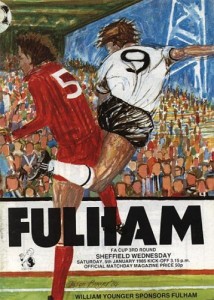
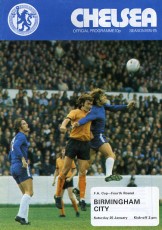 My match day experience is not complete unless I am able to get a programme. Over the years there have been just four games when this has happened. Thanks to the Internet the ability to try and get hold of those missing programmes has become easier. Just this week I managed to track down one of the missing four. The game in question was an FA Cup 4th Round game between Chelsea and Birmingham City at Stamford Bridge in 1975. One of the things about programmes for me is the memories that they evoke, in the same way songs, smells or photographs do for other people. They are in their own way a piece of social history. But it is also for me about being there, the shared experience and a confirming of your existence.
My match day experience is not complete unless I am able to get a programme. Over the years there have been just four games when this has happened. Thanks to the Internet the ability to try and get hold of those missing programmes has become easier. Just this week I managed to track down one of the missing four. The game in question was an FA Cup 4th Round game between Chelsea and Birmingham City at Stamford Bridge in 1975. One of the things about programmes for me is the memories that they evoke, in the same way songs, smells or photographs do for other people. They are in their own way a piece of social history. But it is also for me about being there, the shared experience and a confirming of your existence.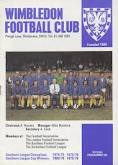 When I lived in London, I would regularly watch around 50 games a season. As well as watching my beloved Fulham, I spend many a Saturday at Plough Lane watching Wimbledon in the Southern League and Tooting & Mitcham in the Isthmian League. It was a chance to watch football without stress, it was cheaper and invariably had a sense of a greater belonging – a friendliness. That is not to say that the football was any less committed, that supporters were less fanatical or rivalries were less intense. I didn’t feel that I was being taken advantage of or being bombarded by advertising and merchandising. Many club officials and those working in the bars and refreshments areas were volunteers and so provided an honesty and integrity when attending the games. Two stand-out memories from those days occurred at Plough Lane and showed a career on the rise and one on the way down. In a London Senior Cup tie in 1978/79 season a 17 year old Dave Beasant played for Edgware Town against Wimbledon. He had a stormer of a game and was later signed up by the Dons on the way to a long and event filled career. A couple of years earlier, Geoff Hurst, cut a rather sad figure leading the forward line as player-manager of Telford United. Not a great memory of England’s 1966 hat-trick hero.
When I lived in London, I would regularly watch around 50 games a season. As well as watching my beloved Fulham, I spend many a Saturday at Plough Lane watching Wimbledon in the Southern League and Tooting & Mitcham in the Isthmian League. It was a chance to watch football without stress, it was cheaper and invariably had a sense of a greater belonging – a friendliness. That is not to say that the football was any less committed, that supporters were less fanatical or rivalries were less intense. I didn’t feel that I was being taken advantage of or being bombarded by advertising and merchandising. Many club officials and those working in the bars and refreshments areas were volunteers and so provided an honesty and integrity when attending the games. Two stand-out memories from those days occurred at Plough Lane and showed a career on the rise and one on the way down. In a London Senior Cup tie in 1978/79 season a 17 year old Dave Beasant played for Edgware Town against Wimbledon. He had a stormer of a game and was later signed up by the Dons on the way to a long and event filled career. A couple of years earlier, Geoff Hurst, cut a rather sad figure leading the forward line as player-manager of Telford United. Not a great memory of England’s 1966 hat-trick hero.